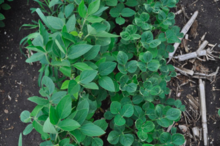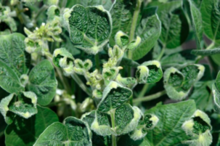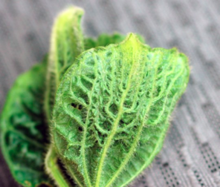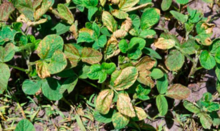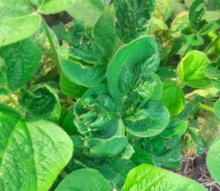Non-Xtend soybeans are extremely sensitive to dicamba. Recently published research found that exposure symptoms occurred in non-tolerant beans at rates as low as one twenty-thousandths of the 1x rate of 0.5 pounds of acid equivalent (ae) formulation per acre.
Understanding dicamba
Dicamba is a plant growth regulator that belongs to the Site of Action Group 4 (SOA-4) herbicides: The synthetic auxins. In a healthy plant, auxins play important roles in promoting cell growth and maintaining normal growth and development.
As a synthetic auxin, dicamba disrupts the plant’s normal hormonal balance, stimulates rapid, uncontrolled cell growth and induces flower abortion. Leaf cupping, caused by this rapid growth, is seen in the non-Xtend soybeans that were exposed to dicamba (Figure 1). At high enough concentrations, abnormal growth caused by dicamba can kill the plant.
Plant injury symptoms don’t develop immediately after exposure. Dicamba is rapidly translocated to actively growing areas in a plant, where injury symptoms will begin appearing on new growth. Leaves already fully developed when the plant was exposed will be less affected.
Researchers at the University of Wisconsin found that the next four leaves that develop after exposure show the most severe symptoms and these might not be noticed for seven to 14 days.
During Minnesota’s 2017 growing season, symptoms from low dicamba concentrations were slow to emerge, showing up 14 to 21 days after exposure.
Soybean injury symptoms reflect the level of dicamba exposure. At low doses, you’d expect to see slight leaf crinkling or cupping. Symptoms become more severe as concentrations increase.
Researchers at the University of Nebraska applied micro-rates of dicamba to non-tolerant soybeans at rates ranging from one-tenth (equivalent to 3 tablespoons per acre) to one-thousandth of the labeled rate. As the rates increased, crop injury became more severe:
-
Reduced plant height.
-
Changes in branching pattern.
-
Delayed canopy closure and flowering date.
-
Reduced flower numbers.
-
Delayed physiological maturity.
-
Reduced soybean yield.
The stage of plant development also affects the severity of injury symptoms. When exposed during early reproductive stages, soybean flowers and pods can be affected and seed abortion may occur. In the Nebraska study, soybeans in the late vegetative, early reproductive stage (V7-R1) were the most sensitive to dicamba.
Symptoms: Dicamba exposure in non-tolerant soybean
Field observations of dicamba injury symptoms during 2017 ranged from cupping and strapping of newly emerged leaves to height reductions and injury to growing points.
What to look for if you suspect dicamba injury
-
Extreme cupping of trifoliolate leaves, which is most pronounced on the upper trifoliolates (Figure 2).
-
Veins of affected leaves tend to assume a parallel orientation instead of the usual net venation pattern (Figure 3).
-
Tips of cupped leaves with parallel veins are often brown- or cream-colored.
-
Plants are stunted compared to plants not demonstrating the above symptoms; these plants may sometimes remain stunted the remainder of the season (Figure 1).
-
Depending on time and dose of exposure, pod development can be adversely affected.
Other causes of leaf distortions
Other leaf symptoms may mimic dicamba injury. As previously mentioned, dicamba exposure symptoms can vary according to the dose of exposure and stage of soybean development. However, the symptoms of low-dose exposure tend to be fairly consistent.
Foliar-applied PPO inhibitors can cause leaf distortions, but the degree of cupping is generally much less than that caused by dicamba.
In addition, PPO symptoms will appear on the leaves that were exposed (Figure 4). In contrast, cupping caused by dicamba is generally seen on leaves that emerge after the exposure occurred.
Distorted leaves following postemergence (POST) applications of soil-residual herbicides may be confused with dicamba injury (Figure 5). However, on close inspection, these symptoms are very different from those caused by dicamba.
Hager, A. (2017). The dicamba dilemma in Illinois: Facts and speculations.
Ikley, J. & Johnson, B. (2017). Response of Roundup Ready soybean yield to dicamba exposure.
Knezevik, S. (2018). Research on the impact of dicamba micro-rates on non-tolerant soybean.
Werle, R., Proost, R. & Boerboom, C. (2018). Soybean injury from dicamba.
Reviewed in 2021


